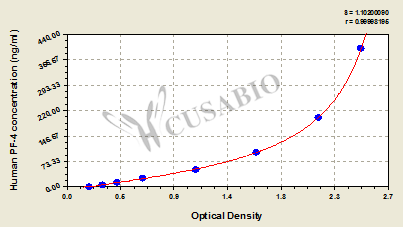The human PF4 ELISA kit (CSB-E07882h) is designed for the quantitative measurement of human PF4 protein in serum, plasma, or tissue homogenates. It quantitates human PF4 with 1.56 ng/ml sensitivity and shows excellent specificity for human PF4. It uses the bi-antibody sandwich enzyme immunoassay technique. This assay employs a biotin-conjugated PF4 antibody that recognizes the analyte bound by the immobilized PF4 antibody, forming an antibody-analyte-antibody complex. The immune complex is further detected by avidin-conjugated HRP. The TMB solution is added into the wells and turns blue and finally turns yellow after the addition of the stop solution. Solution color develops in proportion to the amount of PF4 in the sample. The O.D. value is measured using a microplate reader at 450 nm and is used to determine the concentration of the human PF4 in the sample.
Human PF4 is a positively charged tetramer that is stored within platelet α-granules and is released upon platelet activation. PF4 suppresses local antithrombin III activity by binding with high affinity to heparin-like molecules thus promoting coagulation. Additionally, Pf4 participates in many other biological processes including promoting the survival of hematopoietic stem cells and inhibiting the proliferation of endothelial cells and fibroblasts. PF4 also plays an important role in the pathogenesis of atherosclerosis. As a pleiotropic inflammatory chemokine, PF4 is involved in various inflammatory diseases including liver fibrosis. PF4 regulates the immune system by promoting recruitment, survival and differentiation of innate and adaptive immune cells, such as monocytes/macrophages.
